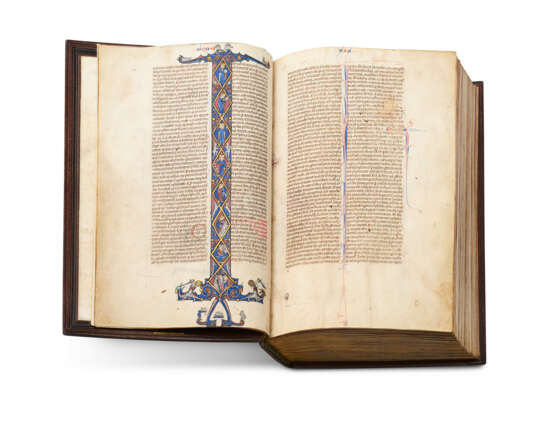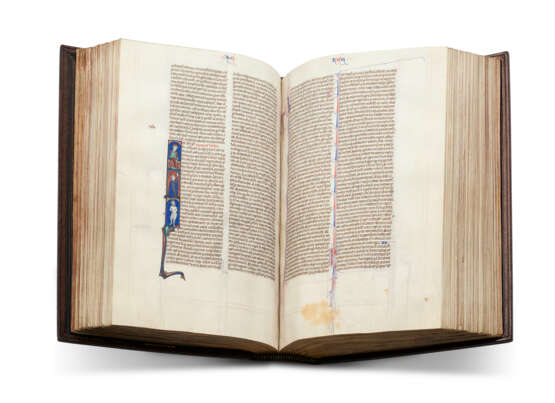ID 794523
Los 22 | The Bari Atelier
Schätzwert
£ 80 000 – 120 000
Bible, with the Prologues attributed to St Jerome and the Interpretation of Hebrew Names, in Latin, illuminated manuscript on vellum [Paris, third quarter of the 13th century].
An arresting, complete, Parisian Bible richly illuminated by the Bari Atelier, with exceptional late medieval and early modern English provenance from John, Lord Lumley to William Cecil, 1st Baron Burghley; Robert, 2nd Lord Elgin and Earl of Ailesbury; and Sir Thomas Mostyn.
212 x 142mm. 490 leaves, complete, collation: 1-3016, 3110, catchwords from f.272v onwards survive within elaborate animalistic cartouches (dragons, a chicken, a fish), 51 lines in two columns, ruled space: 148 x 87mm, headings in red, capitals touched in red, versal initials in Psalms and Interpretations alternately red and blue, chapter numbers and running titles alternately in red and blue, chapter initials in red or blue with full-length penwork in both colours, textual corrections within red and blue cartouches, 84 large illuminated initials and 81 historiated initials (some wear, a few initials smudged, some cockling to opening leaf, a few wormholes, some thumbing and marginal cropping, but generally in excellent condition). Late 19th-century dark brown blind-stamped morocco, title gilt, gilt edges, by Rivière & Son (light wear to spine).
Provenance:
(1) Although the illumination is undoubtedly French, the quality of the vellum and the script has all the hallmarks of an Italian production of the late 13th century.
(2) John Lumley: an inscription on f.290 reads ‘John Lu[m]ley ys the onor of […] boke by our […] fathe yt […] ryds thys’. The inscription is datable to the first half of the 16th century, so this is most likely John, 4th/5th Baron Lumley (1493-1545), who fought in the Battle of Flodden and whose son George Lumley was executed for his role in the Pilgrimage of Grace. Upon the death of John, the 1st and 2nd creations of the peerage were forfeited as a result of George’s attainder, but the Lumley estates passed to George’s son, also John, one of the greatest collectors of art and books of his age, custodian of Nonsuch Palace, who in 1547 successfully petitioned for the restoration of the barony to become John Lumley, 1st Baron Lumley.
(3) Most likely from the Library of William Cecil, 1st Baron Burghley (1520-1598), Lord High Treasurer of England, twice Secretary of State, and favourite of Queen Elizabeth. After his death, Lord Burghley’s manuscript collection passed to his eldest son, Thomas, first Earl of Exeter (1566-1640), and from him to Lord Exeter’s second daughter, Lady Diana Cecil (d.1658), who in turn left the library to her second husband, Thomas, 1st Earl Elgin (1599-1663). His son by his first marriage was Robert, 2nd Lord Elgin, Chancellor of England, created Earl of Ailesbury in 1685. The library was dispersed after the latter’s death, and the present manuscript was lot 78 among the Latin manuscripts in the Ailesbury sale, London, 21 November 1687, sold for 10s.
(4) Sir Thomas Mostyn (1651-1692), of Gloddaeth, in Llandudno: blue Gloddaeth Library bookplate on inside upper cover, probably added at the time of Edward Parry’s cataloguing of the Library in 1842. It was no 8 in the catalogue of the Library in 1692 (‘Sacra Biblia cum prolegomenis Hieronimi. Membr.’; see D. Huws, ‘Sir Thomas Mostyn and the Mostyn Manuscripts’, Books and Collectors, 1200-1700, 1997, p.465). It was subsequently no 72 in the catalogue of the Library of the 4th Baronet, also Sir Thomas Mostyn, in 1744: this number is in brackets on f.1. It was then no 219 in the catalogue of manuscripts at Mostyn Hall in the Fourth Report of the Royal Commission on Historical Manuscripts, Appendix, 1874, p.347. Sold at Sotheby’s, 13 July 1920, lot 6, to Quaritch.
(5) Quaritch, A Catalogue of Illuminated and Other Manuscripts together with some Works on Paleography, 1931, no 2, sold to a private collector in March 1943.
(6) Neil F. Phillips, Esq., Q.C. (1924-1997), sold at Sotheby’s 2 December 1997, lot 54 for £58,000.
Content: Bible, with the customary prologues, ff.1-451v; Interpretation of Hebrew Names ff.451v-490v.
Illumination:
The illumination has been attributed to the Parisian Bari Atelier, named from a Gradual now in S. Nicola in Bari: the present manuscript is one of seven Bibles recorded by Branner by this workshop (R. Branner, Manuscript Painting in Paris during the Reign of St Louis, 1977, p.229, ‘Ex-Mostyn collection’, and pp.98-107). Masters at conveying events and emotions on a small scale, the Bari illuminators gave their figures expression by exaggerating postures and hands, all arrestingly outlined in black on a white flesh tone. The figures have tapered bodies, looped and shaded drapery, and large heads with features pushed to the front. The faces, with their wide open eyes and downturned mouths, and omega-shaped locks over the ears (as in the figure of Christ in the genesis initial on f.3v), are a distinctive feature of the atelier from the late 1250s onwards. The appealing initials, their intricate patterns sometimes enlivened by beasts and grotesques, are also characteristic of this group. Parallels can be drawn with a Bible and a Missal at the Bibliothèque nationale in Paris (Bnf Latin 16 and 830), but some of the initials in our manuscript – for example the initial with Haggai and King Cyrus on f.336v – also draw on features of another branch of the Bari Atelier, that responsible for the illumination of the famous Roman de Poire (Paris, BnF Français 2186): high, arched eyebrows and elongated eyes producing a very stylised face.
The subjects of the historiated initials are as follows: 1. a monk writing (f.1); 2. the Seven Days of Creation and the Crucifixion, initial the full height of the page including birds, hounds and rabbits, grotesques, naked warriors, fish, knights fighting from the backs of dragons, an archer shooting an owl, and a flock of sheep (f.3v); 3. Moses addressing the children of Israel (f.21v); 4. the Israelites offering a lamb on an altar (f.36); 5. Moses counting the Jews (f.46); 6. Moses preaching to the Jews (f.60); 7. the king of Jericho in the night with Joshua's two spies (Joshua 2:2, f.73v); 8. Gideon as an armed soldier in chain mail (f.82v); 9. Elimelech with Naomi and two children (f.91v); 10. Elkanah asking Hannah why she is not eating (f.93v); 11. the beheading of the Amalekite (f.106); 12. an attendant bringing Abishag to David in bed (f.116v); 13. Ahaziah falling from a tower (f.128v); 14. A company of Jews (f.140); 15. Solomon in prayer at an altar (f.151); 16. King Cyrus with Ezra the prophet (f.164v); 17. Nehemiah speaking to God (f.168); 18. a priest asperging an altar (f.173); 19. the swallow flying above Tobit in bed (f.179); 20. Judith cutting off the head of Holofernes (f.182v); 21. King Ahasuerus and Esther with the hanging of Haman (f.187v); 22. Job visited by his wife (f.192v); 23. King David with his harp (f.201v); 24. David pointing to his mouth (f.205); 25. David pointing to his eyes (f.207); 26. the fool with club and ball (f.209); 27. David in the water calling to God above (f.211); 28. David playing the bells (f.214); 29. priests singing at a lectern (f.216); 30. the Trinity (f.218v); 31. King Solomon chastising a boy (f.224); 32. Solomon enthroned (f.231v); 33. Ecclesia with chalice and cross (f.234v); 34. Solomon giving a sword to a young man (f.235v); 35. a prophet receiving wisdom from God (f.241); 36. Isaiah sawn in half (f.256); 37. the lapidation of Jeremiah (f.273, very rubbed); 38. Jeremiah watching the fall of Jerusalem (f.293v); 39. Baruch writing, attended by an angel (f.295v); 40. the vision of Ezekiel (f.298); 41. Daniel in the lion’s den (f.316v); 42. Hosea and Gomer (f.324); 43. Joel seated (f.327); 44. Amos as a shepherd among his flocks (f.328); 45. Obadiah seated (f.330v); 46. Jonah and the whale (f.331); 47. Micah seated (f.321v); 48, Nahum watching the fall of Nineveh (801.3331): 49, Habbakuk seated (f.334v); 50. Zephaniah seated (f.335v); 51. Haggai and King Cyrus (f.336v); 52. Zachariah standing (f.337v); 53. Malachi speaking to God (f.340v); 54. the beheading of the idolatrous Jew (f.342); 55. a king receiving a messenger (f.353); 56. a Jesse tree with three descendants (f.361v); 57. St Mark standing (f.372v); 58. Zachariah in the temple (f.380, partly smudged); 59. St John standing f.392v; 60-71 St Paul seated holding a sword or speaking to God (ff.402, 406v, 411, 414, 415v, 417, 418, 419, 420, 420v, 422, 423); 72, the Ascension of Christ (f.427v); 73. St ]ames standing (f.440); 74. St Peter seated with a key (f.441v); 75. St Peter speaking to another apostle (f.442v); 76. St John standing (f. 443v); 77. St John standing (f.443v); 78. St Peter standing (f.444v); 79. St Jude standing (f.445); 80. St John writing to the churches of Asia (f.445v); and 81. A Hebrew writing a book (f.451v).
Special notice
No VAT on hammer price or buyer's premium.
| Herkunftsort: | Westeuropa, Frankreich, Europa |
|---|---|
| Kategorie des Auktionshauses: | Handschriften des Mittelalters und der Renaissance |
| Herkunftsort: | Westeuropa, Frankreich, Europa |
|---|---|
| Kategorie des Auktionshauses: | Handschriften des Mittelalters und der Renaissance |
| Adresse der Versteigerung |
CHRISTIE'S 8 King Street, St. James's SW1Y 6QT London Vereinigtes Königreich | |
|---|---|---|
| Vorschau |
| |
| Telefon | +44 (0)20 7839 9060 | |
| Aufgeld | see on Website | |
| Nutzungsbedingungen | Nutzungsbedingungen |








